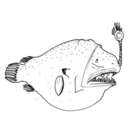en
names in breadcrumbs


View data on Catalog of Fishes here.
Metamorphosed females with esca bearing a pair of elongate internally pigmented (except for distal tip) and bilaterally placed anterior appendages, less than one-tenth to greater than length of escal bulb; one to three, transversely placed, medial escal appendages, bifurcated at mid-length to highly filamentous from base, darkly pigmented in some large specimens (102 and 103 mm); medial escal appendages may arise at any point from distal surface of escal bulb to anterior margin of swollen basal portion of posterior escal appendage; a posterior escal appendage consisting of a swollen basal portion and a membranous distal crest, darkly pigmented in largest known specimens (102–170 mm), and bearing one to several filaments anteriorly or distally in some specimens; anterolateral appendages and basal series of filaments absent; in most specimens a subcutaneous internally pigmented descending appendage.
Illicial length 22.4–40.3% SL; escal bulb width 5.3–11.4% SL; total number of teeth in upper jaw 28–40, in lower jaw 34–57; ratio of number of teeth in upper jaw to number in lower jaw 0.70–0.94; vomerine teeth 4–8; dorsal-fin rays 6–8; anal-fin rays 5 or 6; pectoral-fin rays 17–22.
In addition to characters of the esca, which differentiate C. longiceps from all other species of Chaenophryne, metamorphosed females of this species can be further distinguished from C. draco and C. melanorhabdus by having a smaller ratio between the number of upper and lower jaw teeth. The illicium of C. longiceps appears to be slightly shorter than that of C. ramifera and slightly longer than that of C. melanorhabdus. Chaenophryne longiceps has fewer dorsal- and anal-fin rays than C. ramifera, and a greater number of pectoral-fin rays than all other species of the genus.
Chaenophryne longiceps has a wide geographic distribution, occurring in all three major oceans of the world. It has been collected on both sides of the North Atlantic from the equator to the northern coast of Iceland. Three records are known from the Indo-Pacific region: in the Indian Ocean from the Arabian Sea (approximately 7°N, 65°E) and Bay of Bengal (9°N, 90°E), and from the South China Sea. In the Eastern Pacific, records extend from as far west as the Hawaiian Islands, between approximately 45°N off the coast of Oregon and 23°S off Chile. The lectotype of C. longiceps was collected from the Gulf of Panama.
Based on maximum depths reached by fishing gear, metamorphosed female specimens of C. longiceps are vertically distributed between approximately 500 m and an unknown lower limit. Eighty-eight percent of the known material (28 individuals) was captured by gear fished below 850 m. The largest known specimens (3 individuals, 102–170 mm) were captured by nets fished below 950 m. Material is insufficient from any one geographic area for a more analytical treatment of distributional data.
Meso- to bathypelagic.
Pietsch TW. 2009. Oceanic Anglerfishes: Extraordinary Diversity in the Deep Sea. Berkley: University of California Press. 638 p.
The body of metamorphosed females is short and globular. The mouth is large, its cleft extending past the eye. The illicium length is 20.1–47.4% SL, becoming longer proportionately with growth. The anterior end of the pterygiophore of preserved specimens is usually concealed under the skin, within the illicial trough, but apparently capable of considerable forward extension (as in Oneirodes and ceratiids). The esca bears paired, conical to elongate, anterior escal appendage or appendages, internally pigmented, with one or three round translucent windows at its tip. A filamentous medial escal appendage or appendages are present. A posterior escal appendage, consisting of a swollen basal portion and a compressed distal crest, is present, bearing none to numerous filaments anteriorly or distally, without a pair of fringed anterior lobes. A subcutaneous internally pigmented appendage emerges from the base of the esca and descends along the anterior margin of the illicial bone
The teeth are slender, recurved, and all depressible, arranged in overlapping sets as described for other oneirodids. The teeth in the lower jaw are larger and slightly more numerous than those in the upper jaw. There are 21–51 teeth in the upper jaw and 26–57 in the lower jaw. Jaw teeth are few and rudimentary in specimens smaller than approximately 18 mm. The vomer bears 4–8 teeth, the longest tooth outermost. The second and third pharyngobranchials are well developed and toothed. Epibranchial and ceratobranchial teeth are absent.
As with most oneirodid taxa, males of the genus Chaenophryne are free-living and presumed non-parasitic.
Known from 84 metamorphosed females (10–245 mm); two females in metamorphosis (12–12.5 mm); seven metamorphosing, juvenile, and adult males (11–19.5 mm); and 106 larvae (62 females, 42 males, and 2 undetermined, 3.2–19 mm TL).
DANA station 1203(11), Gulf of Panama, 7°30'N, 79°19'W, 3000 m of wire, 1500 hr, 11 January 1922.
Lectotype of Chaenophryne longiceps: ZMUC P92106, 20 mm.
Chaenophryne longiceps, commonly known as the can-opener smoothdream, longhead dreamer or smooth-head dreamer, is a species of anglerfish in the family Oneirodidae (dreamers).[3][4][5][6][7]
Chaenophryne longiceps is known for its monstrous appearance: inky black in colour with sharp pointed teeth (28–40 in upper jaw, 34–57 in lower) and (in females) a pointed lure (esca) protruding from its forehead.[8] The maximum length of females is 28 cm (11 in); the males are about 2 cm (0.79 in) and attach themselves to the female with special denticles, but are not parasitic.[9][10] It has 6–8 dorsal soft rays and 5–6 anal soft rays. Its specific name, longiceps, means "long head."[11]
Chaenophryne longiceps is bathypelagic, living at depths of 500–1,000 m (1,600–3,300 ft) in tropical to temperate parts of all the earth's oceans. In 2010 it was found off Greenland for the first time.[12]
Feeds on fish, cephalopods and crustaceans.[11]
Chaenophryne longiceps, commonly known as the can-opener smoothdream, longhead dreamer or smooth-head dreamer, is a species of anglerfish in the family Oneirodidae (dreamers).